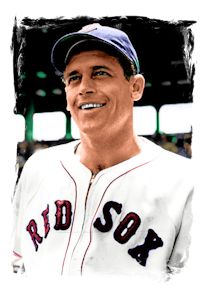 |
James "Jake" Jones was born on November 23, 1920, in Epps, Louisiana. Following his graduation from high school in 1938, he began his baseball career in Louisiana with the semipro Clarks Lumbermen. In 1939, he played for Monroe in the (Class C) Cotton States League, and in 1940 he played for Shreveport in the (Class A1) Texas League and was on the fast track to the majors. In addition to his powerful bat, he displayed an innate ability to scoop up low throws around first base. Jake reached his peak in the Texas League all-star game at Beaumont, and was the whole show, acclaimed as the most valuable player. A number of big league teams were bird-dogging Jake and led the Texas League with 24 homers for the season. He was signed by the Chicago White Sox in August 1941. Sent back down to the minors for additional seasoning, Jake then enlisted in the Navy during the summer of 1942. Despite never having gone to college, he was selected for flight training and was commissioned an ensign. He also played basketball at the University of North Carolina while in the service. The USS Yorktown was the second aircraft carrier of that name to serve in World War II, the original being lost at the Battle of Midway and Jake joined the ship in time for her second deployment to the Pacific. For two weeks in November 1944, they launched air strikes on targets in the Philippines in support of the invasion of Leyte. It was during this action that Jake was awarded his first Air Medal. He performed his assignment as wingman for the Air Group Commander in an outstanding manner and destroyed an enemy fighter during the attack. Promoted to lieutenant junior grade, he quickly picked up a second Air Medal. Participating in a strike against the enemy, he pressed home a daring attack against three enemy fighters, destroying one, inflicting severe damage on another and forcing the third to flee. Ten combat missions in the vicinity of Formosa, China, French Indo-China and Nansei Shoto earned him his third and fourth Air Medals. A week later, he won his first Distinguished Flying Cross, when he carried out a low altitude attack in the face of intense antiaircraft fire, scoring rocket hits to set a large hostile oiler on fire and contributing to the success of the mission. In February, they launched strikes on mainland Japan near Tokyo where Jake downed five enemy planes to win the Silver Star and another Distinguished Flying Cross. He countered aggressive, determined and skillful attacks by numerically superior enemy fighters and after air opposition had been neutralized, he with his wingman, made low-level rocket and strafing attacks against air field installations, securing destructive hits on each of six hangers. Jake did get to play some baseball between flights, but not too much. He returned home a hero and received a week of shore leave in New York City, where he appeared on the Kate Smith radio show. Returning to baseball after the war, Jake was the only legitimate power threat on a White Sox team that finished last in the American League in 1946. Though he had returned unscathed from the Second World War, he did not have the same luck on the baseball diamond. In May, he suffered a season-ending fracture of his left wrist and elbow. He subsequently had trouble straightening out his surgically repaired arm and carried around a bucket of sand for several hours a day for physical therapy. Jake saw little playing time in April 1947, but in May, he had six doubles and three home runs for the still punchless White Sox squad. Then his bat went silent and he was traded to the Red Sox. Manager Joe Cronin swapped slumping first baseman Rudy York, who had knocked in 119 runs for the AL champs in 1946 to the visiting Chicago White Sox for Jake. In his first 11 games with the Red Sox, all played in Boston, Jake hit .302 with three doubles, three home runs, and a triple. His swing was tailor-made for Fenway Park, where in 1947 he hit .280 with 14 home runs. But the line on Jake was that he didnít show much emotion on the field and he chased low outside curves. Soon the opposing teams started stacking the deck, bunching their men on the left side of second base, just the opposite of the way they played Ted Williams. But Jake was still very capable of delivering the big hit. Joe McCarthy replaced Joe Cronin as Red Sox skipper after the 1947 season. He did not share the same opinion of Jakeís ability as id Cronin and in December, two months before spring training, announced that outfielder Stan Spence, newly acquired from the Senators, would be his first baseman in 1948. Spence got off to a slow start, so at the end of April, Jake replaced Spence, but neither he nor Spence could make a bold enough statement with the stick, both hitting at a tremendous .222 clip. So McCarthy gave rookie Billy Goodman the first basemanís mitt while Jake rode the pine, remaining with the club all year, but seeing virtually no action in the second half of the season. Jake played one last season, in 1949, hitting .243 with 18 homers for Louisville and then San Antonio in the Texas League. He returned to his hometown, where he owned a 400-acre cotton farm and operated a flying service, doing mostly crop-dusting work. He was recalled to active duty during the Korean War, and helped train pilots. He continued to fly without incident until, to the great relief of his wife, gave it up in 1980. Jake Jones died at age 80, on December 13, 2000, in Epps, Louisiana. |
|||||
